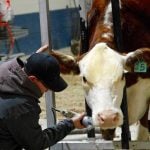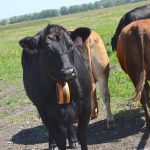A scientist at the University of Alberta in Edmonton has used biotechnology to develop a method of reducing green seed in Argentine canola.
The research, carried out with support from the Western Grains Research Foundation Endowment Fund, could have significant benefits for Western Canada.
The green seed problem, most commonly associated with Argentine, has traditionally meant more expense for the crusher and lower payments for the farmer, said lead researcher Anne Johnson-Flanagan. It has also reduced the areas in which Argentine can be successfully grown.
Read Also

Trump cuts off trade talks with Canada
(Reuters) – U.S. President Donald Trump said on Thursday that all trade talks with Canada were terminated following what he…
A seed can be mature and even top grade quality, but if it is green, the price goes down.
That is because the crusher has to remove the green from the oil, which is costly.
“They have to use bleaching clays,” explained Johnson-Flanagan.
“The bleaching clays are expensive, and they can’t be rejuvenated so they have to go to a landfill. They also absorb a fair bit of oil in the process.”
Scientists set out to reduce the amount of green pigment in the seeds.
The most common cause of green seed problems in Argentine is stress, whether biological, such as blackleg, or environmental, such as frost. Since Argentine takes longer to mature than other canolas, it is more susceptible to frost.
The green color in plants is linked to chlorophyll, which is most often associated with chlorophyll A/B binding (CAB) proteins. In a normal relationship, the CAB proteins bind to the chlorophyll and support biosynthesis in the early stages of development.
As the plant matures, the bond between the CAB proteins and the chlorophyll destabilizes, and the chlorophyll breaks down naturally.
After a plant suffers frost stress, scientists have observed substantial increases in chlorophyll. They determined that frost causes the plant to regress in a way, switching the balance back to biosynthesis and thus, chlorophyll production instead of degradation.
“We decided the best way to reduce the green pigment was to try to do something to destabilize the CAB protein/chlorophyll complex,” Johnson-Flanagan said.
The technique scientists used involved transgenics – inserting a new gene into a plant. In this case, a complementary gene was added to suppress production of CAB.
A crucial aspect to the study was that researchers had to ensure the gene worked only in the seed, otherwise the plant would not contain enough chlorophyll.
To do this, scientists used a seed-specific promoter or switching mechanism, which programs the gene to work at a certain time during the seed’s development. The gene is intended to suppress production of the CAB and thus promote chlorophyll degradation.
Scientists could then move to the testing phase of the study.
First, they tested the response of the new gene during seed development under controlled laboratory conditions. They found the gene had little negative effect aside from a slight reduction in seed dry weight.
Most importantly, chlorophyll was reduced up to 50 percent in one line.
This first test was done in a laboratory environment looking at normal seed development under normal conditions.
“Odds are, in that situation, you’re not going to have a problem,” Johnson-Flanagan said. “We wanted to be more convincing than that, so we added a stressor to the study.”
Researchers exposed the plants to frost.
They took a control group of plants, which did not contain the gene, and a case group, with the gene. Both groups were exposed to frost and scientists tracked seed development from the time after frost until plant maturity.
When checked, “the control plants had a severe green seed problem, while the transgenic lines had essentially no green seed. The level of pigment in the transgenic line seed was almost exactly the same as the non-frozen control plants.”
Scientists will test the strategy in fields and hope to see a commercial cultivar developed.
Johnson-Flanagan estimated it will be at least another two to four years before the material is ready to enter co-op testing.
Research could increase the geographical area where Argentine can be grown, reduce processing costs and ensure full price for top quality seed.














